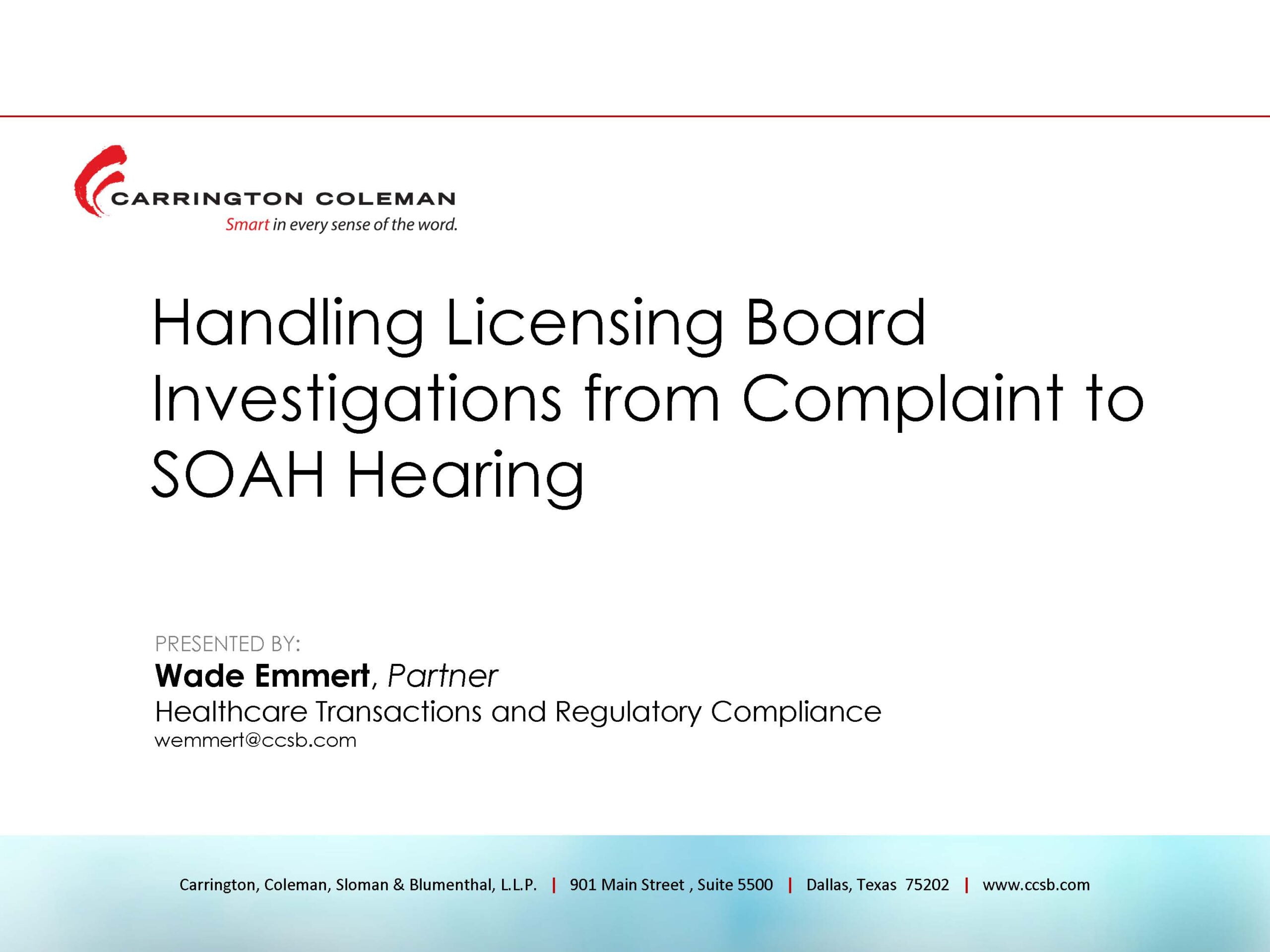There is a mistaken belief that a D.PSc., PSC.D or Doctor of Pastoral Medicine degree from the Texas-based, Pastoral Medical Association, will expand the scope of practice of non-physician, medical providers. Will such a degree allow a nurse practitioner, for example, to provide services or perform medical assessments that they provide could not otherwise perform? Or, can the provider now hold themselves out as a “doctor” without disclosing the type of degree?
Whether disclosed or not, pastoral medical degrees can create confusion about the scope of practice and competency of the provider. Does this “medical” degree confer any authority to offer medical advice to their clients?
There are several internet articles about this degree and potential confusion, but little in the way of public guidance from state agencies.
I searched for disciplinary actions taken by the Texas Medical Board and the Texas Board of Chiropractic Examiners. Reviewing these disciplinary matters, I conclude that advertising or trying to use a pastoral medicine degree in the provision of health care has significant risks.
The Pastoral Medical Association purportedly “qualifies and licenses spiritually-minded health professionals with diverse practice specialties who are committed to partnering with their clients in using scripturally-sound means to achieve and maintain robust mental, physical and spiritual health.” While that description is innocuous enough, the word “Medical” in its name implies a focus beyond its stated purpose.
A problem arises when the activities of the pastoral medicine provider fall within the scope of practice regulated by a Texas licensing board. Because the Pastoral Medical Association is not a governmental agency, it does not have any legal authority to regulate a scope of practice.
Want to see what happens when apastoral medicine provider crosses the line into a scope of practice regulated by the Texas Medical Board or the Texas Board of Chiropractic Examiners?
These are their stories. [Bum. Bum.]
This information was reported publicly by the referenced licensing board. Nevertheless, I have redacted the practitioners’ names.
Texas Medical Board Disciplinary Actions
XXXX XXXXXX, D.C., No TMB License, Austin
On October 25, 2019, the Board directed the Executive Director to enter a Cease and Desist Order regarding XXXX XXXXXX, D.C., prohibiting him from practicing medicine in the state of Texas without a license issued by the Texas Medical Board. Mr. XXXXXX shall not refer to himself as a medical doctor or physician in any manner, by designating himself by using “doctor,” or “Dr.” unless he also designates that he is a doctor of chiropractic as required by the Texas Occupations Code. The Board found Mr. XXXXXX advertised his Doctor of Pastoral Medicine as Dr. XXXX XXXXXX, PSc.D., which is not recognized in Texas and no disclaimer was provided. Mr. XXXXXX does not identify himself as “D.C.” or “Doctor of Chiropractic” after calling himself “Dr.” on his website.
XXXX XXXXXX, No TMB License, Conroe
On August 25, 2017, the Board and XXXX XXXXXX, entered into an Agreed Cease and Desist Order prohibiting Mr. XXXXXX from practicing medicine in the state of Texas without a license issued by the Texas Medical Board; shall cease and desist any unlicensed practice of medicine; and shall cease and desist from identifying himself as a doctor. The Board found Mr. XXXXXX operates a business under the name Simple Wellness and a website and Facebook page where he claims to offer various health services, including “Frequency Specific Microcurrent (FSM) which can be used to treat the following: scar reduction, pain, injuries, fat loss, performance and recovery, energy mood, brain injury, nerve issues, stress trauma, emotions, anxiety, sleep, addiction, ADHD/Focus, autism, depression and PTSD” Mr. XXXXXX also advertises these services in publications such as Psychology Today where he refers to himself as Dr. XXXX XXXXXX,, and states on his website and other promotional materials that he is licensed by the Pastoral Medical Association, an entity that does not confer any authority upon Mr. XXXXXX to practice medicine in the state of Texas under the Medical Practice Act.
XXXX XXXXXX, D.C., No TMB License, Plano
On June 16, 2017, the Board and XXXX XXXXXX, D.C., entered into an Agreed Cease and Desist Order prohibiting Ms. XXXXXX from practicing medicine in the state of Texas, shall cease and desist using the titles Doctor, Medical Doctor, or Physician unless licensed by the Texas Medical Board. Because Ms. XXXXXX is a licensed Chiropractor, she may use the title of “Doctor of Chiropractic” or “D.C.” Ms. XXXXXX shall cease and desist from using the post-nominal titles of Doctor of Functional Medicine, Doctor of Pastoral Medicine, or any other title that is not recognized by Texas as an authority authorizing her use of the prenominal title of Doctor. Ms. XXXXXX shall denote in all promotional materials and biographies that she is not licensed to practice medicine in Texas. The Board found Ms. XXXXXX has identified herself in online promotional materials and biographies using the prenominal title Doctor and used the post-nominal title of Doctor of Pastoral Sciences and Functional Medicine Doctor as the authority authorizing her use of the prenominal title of Doctor neither of which is recognized in the state of Texas.
XXXX XXXXXX, D.C., No TMB License, Austin
On June 10, 2016, the Board and XXXX XXXXXX, D.C., entered into an Agreed Cease and Desist Order prohibiting Mr. XXXXXX from acting as, or holding himself out to be, a licensed physician in the state of Texas. The Board found Mr. XXXXXX’s website and other promotional materials did not make it clear that he does not treat thyroid disease, diabetes, Hashimoto’s disease, fatigue, digestive issues, and autoimmune disorders. Mr. XXXXXX’s website and other promotional materials state he is licensed by the Pastoral Medical Association. This entity does not confer any authority upon Mr. XXXXXX to practice medicine in the state of Texas under the Medical Practice Act.
XXXX XXXXXX, No TMB License, Galveston
On March 4, 2016, the Board and XXXX XXXXXX entered into an Agreed Cease and Desist Order, prohibiting Mr. XXXXXX from acting as, or holding himself out to be, a licensed physician in the state of Texas. Mr. XXXXXX shall cease and desist any practice of medicine and desist from identifying himself as a doctor, unless he does so in compliance with Healing Arts Identification Act. The Board found Mr. XXXXXX refers to himself as Dr. XXXXXX or “doctor” in publications and online without specifying an authority for the use of the title of “Dr.” or “doctor.” Mr. XXXXXX’s website and other promotional materials state he is licensed by the Pastoral Medical Association. This entity does not confer any authority upon Mr. XXXXXX to practice medicine in the state of Texas under the Medical Practice Act.
XXXX XXXXXX, No TMB License, The Woodlands
On March 4, 2016, the Board and XXXX XXXXXX entered into an Agreed Cease and Desist Order, prohibiting Mr. XXXXXX from acting as, or holding himself out to be, a licensed physician in the state of Texas. Mr. XXXXXX shall cease and desist from identifying himself as a doctor, unless he does so in compliance with Healing Arts Identification Act. The Board found Mr. XXXXXX refers to himself as Dr. XXXXXX or “doctor” in publications without specifying an authority for the use of the title of “Dr.” or “doctor.” Mr. XXXXXX’s website and other promotional materials state he is licensed by the Pastoral Medical Association. This entity does not confer any authority upon Mr. XXXXXX to practice medicine in the state of Texas under the Medical Practice Act.
XXXX XXXXXX, D.C., No TMB License, San Antonio
On March 4, 2016, the Board and XXXX XXXXXX, D.C., entered into an Agreed Cease and Desist Order, prohibiting Mr. XXXXXX from engaging in the unlicensed practice of medicine. Mr. XXXXXX shall indicate on each page of his website and other advertising, where the term “doctor or “Dr.” appears, that he is a doctor of chiropractic. In addition, where reference to the Pastoral Medical Association (PMA) appears on his website and other advertising, Mr. XXXXXX shall indicate PMA is not a state licensing agency, and he will comply with Tex. Occ. Code 104.004 with respect to the use of the title “doctor” in relation to his “D.PSc” credential. The Board found Mr. XXXXXX has published information, including Internet website pages, other postings, and mailings that did not at all times make it clear that his is not a medical doctor. Some of the material that Mr. XXXXXX posted and mailed could be read to imply that he treats medical and physical conditions, including chronic conditions of persons.
XXXX XXXXXX, No TMB License, Cedar Park
On March 4, 2016, the Board and XXXX XXXXXX entered into an Agreed Cease and Desist Order, prohibiting Mr. XXXXXX from acting as, or holding himself out to be, a licensed physician in the state of Texas. Mr. XXXXXX shall cease and desist from identifying himself as a doctor, unless he does so in compliance with Healing Arts Identification Act. The Board found Mr. XXXXXX refers to himself as Dr. XXXXXX or “doctor” in publications without specifying an authority for the use of the title of “Dr.” or “doctor.” Mr. XXXXXX’s website and other promotional materials state he is licensed by the Pastoral Medical Association. This entity does not confer any authority upon Mr. XXXXXX to practice medicine in the state of Texas under the Medical Practice Act.
Texas Board of Chiropractic Examiners Disciplinary Actions
XXXX XXXXXX, DC, TBCE Lic. No. XXXX, Houston
[Dr. XXXXXX was required to …] Differentiate his chiropractic practice from any other businesses that are outside the scope of chiropractic practice, remove any references of other businesses from his chiropractic website and provide statement in any advertisements referencing “Pastoral Medicine Association” (PMA), that PMA is not a state-regulated entity.










